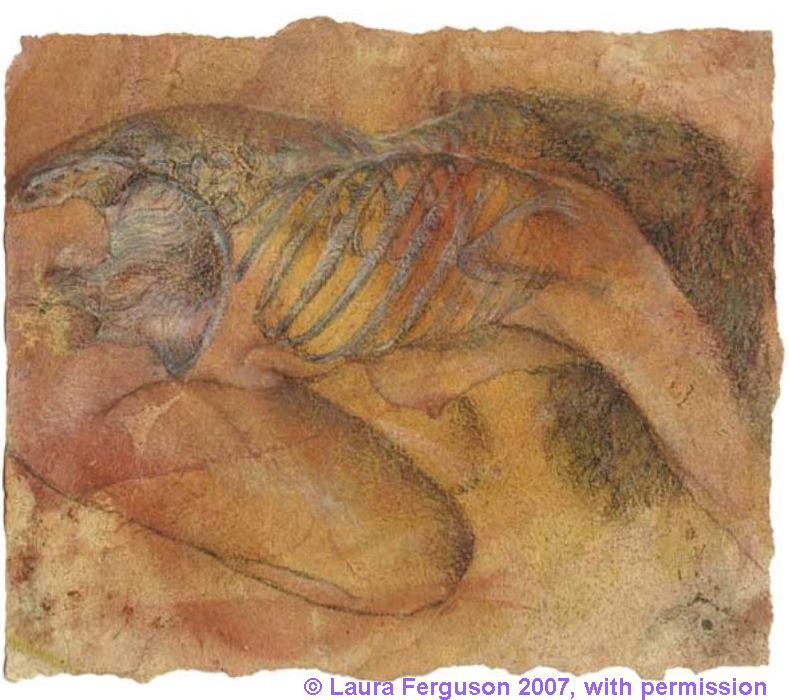Commentary by Laura Ferguson, Artist working in New York City
Can a deformed body be beautiful? Yes, through an artist’s eyes – and I believe art can help medicine to broaden its vision, and embrace a new aesthetic of the body.
I’m an artist and for the past twenty years I’ve been using my own body, inside and out, as the subject of my work. My anatomy is an unusual one because of scoliosis, a curvature of the spine, and I found intriguing visual possibilities in the image of a body that was beautiful yet flawed. My drawings are quite intimate and personal, and at the same time strongly based on science, on an understanding of anatomy and physiology, and specifically on medical images of my own skeleton that were made for this purpose.
To help me deal with pain and physical frailty, I turned to movement practices like yoga, Alexander Technique, and neuromuscular training. I learned how to compensate for muscle and joint imbalances and make subtle postural adjustments. I came to know and feel my body from the inside out, becoming more sensitive to its proprioceptive, inner body sensors and signals. I felt more symmetrical, whole, centered, and three-dimensional in my physical being – and better able to convey that sense of myself through the images I made.
I came to understand scoliosis as having a complex rotational dynamic, arising out of a growth process, albeit one that has gone awry. That allowed me to visualize my curving spine as a manifestation of flowing energy: in my drawings it’s a graceful and sinuous shape that helps me to endow a still figure with movement.
The most powerful response to my work has come from people who have unusual anatomies themselves, and have never before seen such bodies portrayed as beautiful. I’ll let a few of these viewers speak in their own moving and eloquent words:
I have to tell you how deeply exciting and beautiful I find your work. My right arm and leg were amputated two years ago, and I’m just now developing a friendly relationship with my body. You have helped me feel beautiful.
Your pictures have helped me to become more accepting of my body… Your drawings reflect a very whole person, not just a body. The figure is lovely, expressive, open and explorative…. This has had a greater impact than my friends trying to convince me that I can be crooked and desireable both! Well, your work proves that.
Somewhat to my surprise, many doctors and medical professionals also respond strongly to this work. It gives them insights into what it feels like to inhabit such a body, they tell me, and allows them to see beyond the deformed spine to the beauty, humanity, and individuality of the person. Still, almost all the orthopedists who tell me they love my work also try to convince me I should have more surgery – whether or not I’ve asked them for medical advice. Ultimately, it seems they can’t help but see an unusual anatomy as a problem to be fixed.
As an artist, I understand that fixing, healing, transforming an abnormal body into a more normal one, is what gives doctors satisfaction, a sense of accomplishment – that it is their form of creative expression. But the result is that there is no alternative paradigm offered to patients, no acknowledgment that an unusual body might be okay the way it is – that there doesn’t have to be a ‘fix.’
I realize that the idea of deformity having its own beauty, without the need of fixing or altering, is a radical one. But I believe in an alternative vision of aesthetics in medicine, one that gives more value to process, to empathetic connection, than to fixing or curing. Art is a good place to look for an alternative aesthetic: a place where the less-than-perfect body can be shown to have its own kind of beauty, grace, sensuality, originality.









» Blog Archive » 25th Disability Blog Carnival: IF
[…]The entry from the Literature, Arts, and Medicine Blog left me with a smile as I contemplated a world in which an unusual body is beautiful and not something to ‘fix’.
Jo
Quite synchronistic how I received this from someone else’s e-mail and found this blog. Acceptance is key to moving through life in a positive way. What a better way to be okay with our bodies…not what the Western culture teaches. Laura, you are truly amazing.
Mike DOrn
Hi Laura, It has been such a pleasure getting to know you through the Society for Disability Studies, and learning more about your creative process. Mike
Val Broyles
I believe I’ve seen your work! Do you have work hanging at the Medtronic Spine headquarters in Memphis, TN? If so, my compliments. I thought your pieces were beautiful. I went to school for art and now work with http://www.spineuniverse.com. If you have time, send me an email at vbroyles@broad-water.com.
Val Broyles
Felice Aull
Artistic representation of a silent kind of bodily difference– chronic pain — is quite stunningly online at The Pain Exhibit, an exhibit by artists with chronic pain, created and managed by Mark R. Collen. The exhibit is subdivided into sections such as “Pain Visualized,” “But You Look So Normal,” “Suffering,” “Isolation and Imprisonment.” The pain exhibit makes an interesting adjunct to Laura Ferguson’s representation of a visible bodily difference.